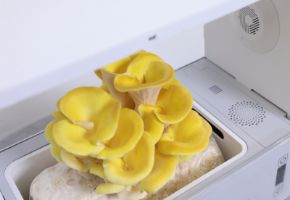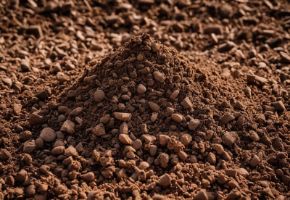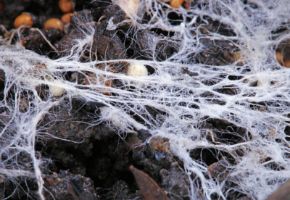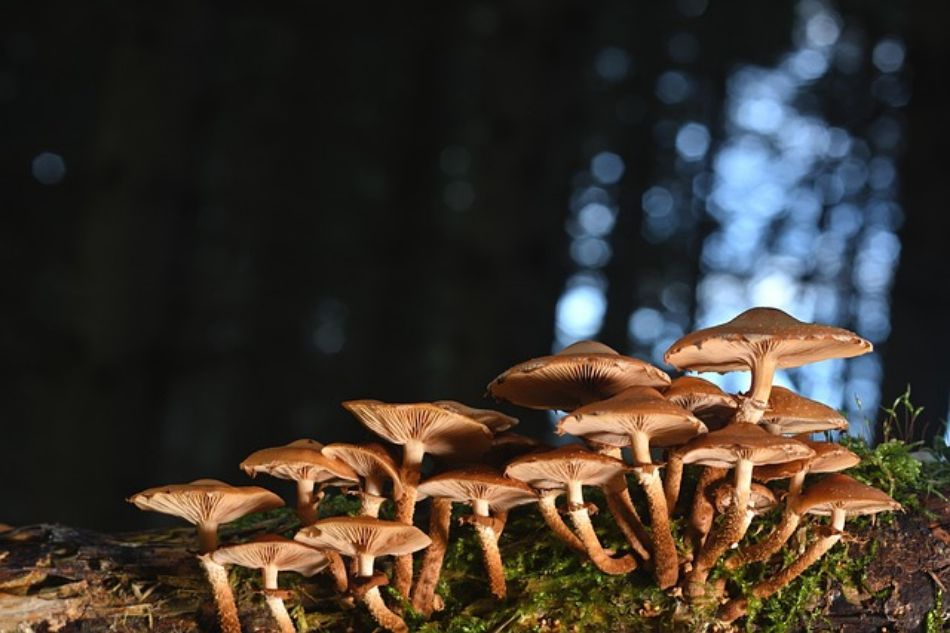The Armillaria mellea, commonly known as Honey Fungus, represents one of the most fascinating and paradoxical examples of the fungal kingdom. This autumn mushroom, beloved by foragers for its intense and distinctive flavor, actually hides a darker side that makes it potentially dangerous if not properly prepared. Its dual nature - poisonous when raw but delicious after proper cooking - makes it a perfect case study for understanding mycological complexity.
Armillaria Mellea: history of the honey fungus
The history of Honey Fungus intertwines with humanity's for centuries. Already Pliny the Elder, in his "Naturalis Historia", described mushrooms with characteristics attributable to Armillaria, noting how some populations consumed them after prolonged boiling. This ancient empirical knowledge anticipated what modern science would only clarify centuries later: the presence of heat-labile toxins that are neutralized by heat.
From a biological perspective, Armillaria mellea belongs to the Physalacriaceae family and is classified as a parasitic-saprophytic species. This means it can both attack living trees (parasitic behavior) and decompose dead plant material (saprophytic behavior). Its adaptability is extraordinary: it can colonize over 600 species of host plants, demonstrating ecological versatility rare in the fungal world.
One of the most surprising aspects of this mushroom is its longevity and expansion capability. Some Armillaria colonies are among the oldest and largest living organisms on the planet. In Oregon, for example, a colony of Armillaria ostoyae (a related species) covering about 8.9 km² has been identified and is estimated to be at least 2,400 years old. These "superorganisms" develop through rhizomorphs - root-like structures that allow the fungus to expand underground in search of new hosts.
Collecting Honey Fungus requires special attention. In many Italian regions it's a well-established autumn tradition, but it's essential to follow some basic rules: never consume them raw, always discard the cooking water, and above all be absolutely certain of identification. There are indeed similar-looking species (like false Honey Fungus of the Hypholoma genus) that can cause serious poisoning.
Morphological characteristics of honey fungus
Correctly identifying Armillaria mellea requires careful analysis of all its morphological features. Honey Fungus presents distinctive characteristics that, when observed methodically, allow for reliable identification even by less experienced foragers.
The cap: shape and color
The Honey Fungus cap varies considerably in size, from 3 to 12 cm in diameter, with a shape that changes during development. In young specimens it appears convex, with the margin typically involute (rolled inward). As it matures, it tends to flatten, often maintaining a more or less pronounced central umbo. The cuticle is sticky and greasy to the touch in humid weather, dry in drought conditions.
The cap coloration represents one of the most variable characteristics and depends on several factors: the mushroom's age, environmental conditions, and especially the host tree type. We can distinguish three main color variants:
- Honey-yellow: the most common hue that gives the species its name ("mellea" derives from Latin "melleus" meaning "honey-like"). This coloration is typical of specimens growing on broadleaf trees like oaks and beeches.
- Reddish-brown: frequent variant on conifer trunks, where the fungus takes on darker, warmer tones.
- Olive-grayish: present in some populations growing on particular substrates like poplars or willows.
The cap surface is often decorated with small dark scales, more evident in young specimens. These scales are actually remnants of the universal veil that covered the fungus in its primordial stage. With age they tend to disappear, leaving the cap smoother and more uniform.
Gills: structure and color
The gills of Armillaria mellea represent an important distinguishing feature. They appear dense and decurrent, slightly running down the stem. In young specimens they're whitish or cream-colored, gradually becoming yellowish and finally staining brownish-pink as the spores mature.
An interesting detail is the presence of lamellulae - shorter gills that don't reach the stem - interspersed among the full ones. This characteristic, observable only by sectioning the mushroom, can aid identification. The spores, en masse, appear white (when young) then cream, and finally take on an ochre hue when mature.
Stem: anatomy and features
The honey fungus stem is another fundamental structure for identification. It presents the following characteristics:
| Characteristic | Description |
|---|---|
| Height | Variable from 8 to 20 cm, slender and elastic |
| Diameter | 0.5-2 cm, often thinner toward the apex |
| Color | Honey-yellow in upper part, darker (brown-ochre) toward base |
| Surface | Fibrous, with evident longitudinal striations |
| Ring | Present in young specimens, white and membranous, tends to disappear with age |
| Base | Often clustered in groups of several individuals, attached to woody substrate |
The ring represents an important but not always reliable characteristic, as in mature specimens it can become evanescent or disappear completely. It's what remains of the partial veil that protected the gills during the fungus's development. In young Honey Fungus it appears as a white curtain descending from the cap edge toward the stem.
Flesh and odor
The Honey Fungus flesh is relatively thin in the cap, more fibrous in the stem (especially the lower part). The color is whitish, tending to pale yellow.
Its odor emits a pleasant mushroomy fragrance, with sweetish notes vaguely reminiscent of honey (hence the species name "mellea"). The raw taste is slightly acrid and unpleasant, a characteristic that should immediately discourage consumption without cooking.
Habitat and geographic distribution
Armillaria mellea is an extremely adaptable species that colonizes a wide variety of forest habitats throughout the northern hemisphere. Its geographic distribution includes all of Europe, North America and temperate Asia, with documented presence in some areas of North Africa too.
Preferred host trees
As a parasite, Armillaria mellea shows preferences but not exclusivity toward certain tree species. The main host categories include:
- Forest broadleaves: Oaks (Quercus spp.), Beeches (Fagus sylvatica), Chestnuts (Castanea sativa), Poplars (Populus spp.), Willows (Salix spp.) and Birches (Betula spp.). These represent about 80% of natural hosts.
- Conifers: especially Firs (Abies alba), Pines (Pinus spp.) and Spruces (Picea abies). On these species the related Armillaria ostoyae is more frequent.
- Fruit trees: apples (Malus domestica), Pears (Pyrus communis), Grapevines (Vitis vinifera) and Olives (Olea europaea) can be attacked, causing significant economic damage.
- Shrubs: under particular conditions it can colonize shrub species like Hazel (Corylus avellana) or Elder (Sambucus nigra).
The host choice considerably influences the fungus's appearance. On broadleaves it tends to develop lighter colors (honey-yellow), while on conifers it assumes darker tones (reddish-brown). This phenotypic plasticity has created considerable taxonomic confusion in the past.
Optimal environmental conditions
A 2021 study published in the National Center for Biotechnology Information (NCBI) analyzed over 1,200 collection sites in Europe, identifying ideal environmental parameters for Armillaria mellea development:
| Parameter | Optimal Value | Growth Effects |
|---|---|---|
| Temperature | 8-18°C (night/day variation) | Below 5°C development stops, above 25°C becomes too stressful |
| Relative humidity | 75-90% RH | Levels below 70% inhibit fruiting body formation |
| Substrate pH | 5.0-6.5 (slightly acidic) | Extreme values (<4 or >8) limit mycelial growth |
| Light | Partial shade (50-70% sunlight) | Full sun inhibits development, complete darkness favors only mycelium |
| Altitude | 0-1,500 m above sea level | Above 1,800 m becomes rare, replaced by hardier related species |
Honey Fungus typically fruits in autumn, from September to November in the northern hemisphere, with possible earlier or later appearances depending on climatic conditions. In particularly rainy years sporophores can be observed as early as late August, while in dry autumns production may delay until December in milder areas.
An interesting ecological aspect is Armillaria's colonization strategy. This fungus can spread both via spores (sexual reproduction) and through underground mycelium (vegetative reproduction). The rhizomorphs - specialized mycelial structures - can grow up to several meters searching for new hosts, allowing the colony to progressively expand through the soil.
Geographic distribution
Armillaria mellea has a cosmopolitan distribution in temperate zones of the northern hemisphere. In Europe it's common in all countries, from Scandinavia to the Mediterranean. In Italy it's present in all regions, from the Alps to the islands, with particular abundance in hilly and foothill areas rich in mixed woods.
In North America the species is widespread on both east and west coasts, with genetically distinct populations. Molecular studies have shown there are indeed differences between European, Asian and American populations, so much that some mycologists propose considering them separate species.
Toxicity and necessary precautions
Raw Armillaria mellea contains several toxic substances that can cause serious food poisoning. Medical literature reports numerous poisoning cases, especially when mushrooms are consumed without proper cooking or in excessive quantities.
Present toxic substances
The main toxins identified in raw Honey Fungus include:
- Hemolysins: heat-labile proteins causing red blood cell destruction (hemolysis), potentially leading to kidney damage.
- Armillarins: compounds irritating to the gastrointestinal tract, responsible for acute symptoms.
- Phenols and derivatives: substances that may cause allergic reactions in sensitive subjects.
- Lectins: proteins that agglutinate red blood cells and may interfere with intestinal absorption.
These substances are all heat-sensitive and are neutralized by prolonged cooking (at least 15-20 minutes in boiling water). It's important to note that simple blanching or insufficient cooking might not be enough to completely break down the toxins.
Poisoning symptoms
Data collected by the Poison Control Center of the Italian National Health Institute describe typical symptom progression:
| Time after ingestion | Main Symptoms | Action Mechanism |
|---|---|---|
| 30 min - 3 hours | Nausea, vomiting, abdominal cramps | Direct irritation of gastrointestinal mucosa |
| 3-6 hours | Watery diarrhea, sometimes hemorrhagic | Increased intestinal permeability |
| 6-12 hours | Headache, dizziness, general weakness | Dehydration and electrolyte imbalances |
| 12-24 hours | Possible jaundice, oliguria | Secondary hepatorenal damage |
In more severe cases, especially in debilitated individuals or children, complications like severe dehydration, acute renal failure or coagulation disorders may occur. Fortunately, with prompt treatment (mainly supportive with rehydration and electrolyte control), the prognosis is generally good.
Guidelines for safe consumption
To enjoy Honey Fungus's gastronomic qualities without risks, it's essential to scrupulously follow these indications:
- Prolonged cooking: boil mushrooms for at least 15-20 minutes in abundant salted water. Simple blanching isn't sufficient.
- Discard cooking water: the heat-labile toxins transfer to the water, which must therefore be eliminated and not reused.
- Moderate quantities: even well cooked, it's advisable not to exceed amounts (max 200-300g per serving).
- First-time collection: inexperienced collectors should have mushrooms checked by an expert mycologist before consumption.
- Don't give to children: not recommended for children under 12 due to greater sensitivity to any residual toxins.
- Preservation caution: home canning requires special precautions to avoid botulism risk.
An additional precaution concerns collection: it's best to avoid Honey Fungus growing on potentially toxic trees (e.g., yew, oleander) or in polluted areas (roadsides, industrial zones), as they can accumulate heavy metals and other harmful substances.
Nutritional properties and health benefits
When correctly cooked, Armillaria mellea becomes not only edible but also a food with interesting nutritional properties and potential health benefits. Analyses conducted by the USDA (United States Department of Agriculture) and other research institutes have outlined a noteworthy nutritional profile.
Nutritional composition
Main components per 100g of cooked Honey Fungus (without cooking water):
| Component | Amount | Notes |
|---|---|---|
| Energy | 35-40 kcal | Low calorie content |
| Water | 88-92 g | High hydration |
| Proteins | 2.1-2.8 g | Contains all essential amino acids |
| Carbohydrates | 4.5-5.5 g | Including 2-3g fiber |
| Fats | 0.3-0.6 g | Mainly unsaturated |
| Beta-glucans | 0.7-1.2 g | Soluble fibers with immunomodulatory effects |
| Potassium | 350-450 mg | Important for electrolyte balance |
| Phosphorus | 80-120 mg | Supports bone health |
| Selenium | 8-15 μg | Powerful antioxidant |
| B vitamins | Variable | Especially B2 (riboflavin) and B3 (niacin) |
The amino acid profile of Honey Fungus proteins is complete, containing all nine essential amino acids, though not in optimal proportions. Combining with cereals (like in classic preparations with rice or polenta) improves overall meal protein quality.
Potential health benefits
Recent scientific studies have investigated various pharmacological properties of Armillaria mellea and its extracts:
- Immunomodulatory activity: a 2019 Korean study published in the Journal of Ethnopharmacology demonstrated that polysaccharides extracted from Honey Fungus can increase macrophage activity by 37% and reduce pro-inflammatory cytokines like TNF-α by 22%.
- Antioxidant effects: present phenolic compounds show free radical neutralizing capacity, with ORAC (Oxygen Radical Absorbance Capacity) activity comparable to many berries.
- Prebiotic properties: beta-glucans and other soluble fibers may promote growth of beneficial gut microbiota bacteria.
- Antimicrobial activity: some extracts have shown in vitro activity against gram-positive bacteria like Staphylococcus aureus.
- Antitumor potential: preliminary animal model studies suggest possible inhibitory effect on some cancer cell line growth, probably mediated by immune system activation.
It's important to emphasize that many of these effects were observed in vitro or animal studies using concentrated extracts. There isn't yet conclusive evidence of efficacy in humans through normal dietary consumption. However, this data opens interesting perspectives for future nutraceutical and pharmacological applications.
Use in traditional medicine
In folk medicine of some regions (especially China and Japan), Armillaria preparations have been traditionally used for:
- Improving blood circulation
- Relieving cramps and tremors
- Treating headaches and dizziness
- Supporting liver function
- Reducing epilepsy symptoms (use documented in Li Shizhen's "Compendium of Materia Medica", 16th century)
In traditional Chinese medicine, Armillaria (known as "Mi Huan Jun") is classified as an herb that "calms internal wind and dissolves convulsions." It's often prescribed in combination with other herbs to treat neurological conditions.
Facts and records about Armillaria Mellea
Armillaria mellea and related species hold several records in the fungal world worth knowing:
The largest living organism on earth
As previously mentioned, in Oregon's Malheur National Forest (USA) a colony of Armillaria ostoyae covering about 8.9 km² (equivalent to about 1,665 soccer fields) was identified. Growth rate estimates suggest this single fungal individual is at least 2,400 years old, making it one of Earth's oldest living organisms.
This "humongous fungus" colony weighs approximately 35,000 tons. It developed mainly underground through a network of rhizomorphs infecting tree roots, causing their death then decomposing the wood.
Other records and curiosities
- Growth speed: Armillaria rhizomorphs can grow up to 1 meter per year, an impressive speed for a fungal organism.
- Bioluminescence: mycelium of some Armillaria species emits faint green luminescence (phenomenon called "foxfire"), observable at night under particular conditions.
- Resistance: rhizomorphs can survive decades in soil even without living hosts, waiting for favorable conditions.
- In history: in 1866, botanist Mordecai Cubitt Cooke described an Armillaria epidemic that destroyed entire orchards in Kent, England, causing significant economic damage.
- In folk culture: some Eastern European regions believed Honey Fungus rings ("fairy rings") were portals to the spirit world.
- In literature: John Wyndham in his novel "The Day of the Triffids" (1951) describes a fictional apocalypse caused by carnivorous plants, inspired by Armillaria's parasitic capabilities.
Armillaria in space
In 2019, an experiment conducted on the International Space Station (ISS) studied Armillaria behavior in microgravity. Results showed rhizomorphs grow about 30% faster without gravity, suggesting interesting applications for future space colonies where fungi could be used to decompose organic materials.
As with all mushrooms: respect and knowledge
Armillaria mellea, or Honey Fungus, perfectly represents the fungal kingdom's duality: potentially dangerous if treated superficially, but extraordinarily interesting and valuable when known and respected. This mushroom teaches us that in mycology there are no shortcuts: only thorough knowledge and rule respect allow enjoying its qualities without risks.
To conclude, here's a recap of main recommendations:
- Certain identification: never collect Honey Fungus without absolute certainty of identification. When in doubt, always consult an expert mycologist.
- Adequate cooking: always boil for at least 15-20 minutes in abundant salted water, then discard cooking water.
- Moderate consumption: even well cooked, it's preferable not to exceed quantities, especially at first tasting.
- Sustainable collection: take only needed amount, avoiding damage to underground mycelium.
- Attention to contraindications: not recommended for children, pregnant women and people with particular sensitivities.
Honey Fungus, with its fascinating biology and crucial ecological role, certainly deserves a place of honor among the most interesting mushrooms to study and, with due precautions, to taste. Whether appreciated for its culinary qualities, extraordinary biological characteristics or its role in forest ecosystems, Armillaria mellea remains one of the most emblematic and representative fungal species of the complex and wonderful world of fungi.
The fungal kingdom is a universe in continuous evolution, with new scientific discoveries emerging every year about their extraordinary benefits for gut health and overall well-being. From now on, when you see a mushroom, you will no longer think only of its taste or appearance, but of all the therapeutic potential it holds in its fibers and bioactive compounds. ✉️ Stay connected - Subscribe to our newsletter to receive the latest studies on: Nature offers us extraordinary tools to take care of our health. Fungi, with their unique balance between nutrition and medicine, represent a fascinating frontier we are only beginning to explore. Continue to follow us to discover how these extraordinary organisms can transform your approach to well-being.Continue your journey into the world of fungi










